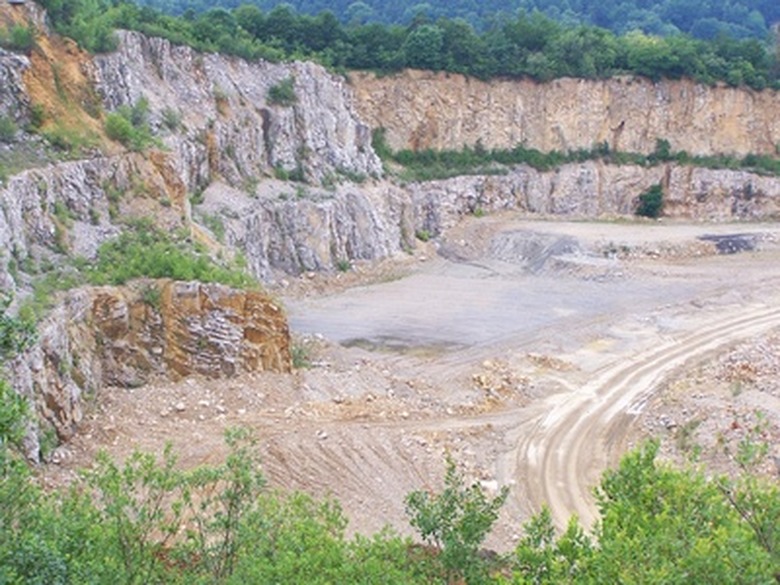Name Five Different Types Of Limestone
As a sedimentary rock mostly composed of calcite, calcium carbonate and the shells and exoskeletons of marine life, many different variations of limestone occur in nature because of the different conditions that produce the rock. It takes millions of years for limestone to form from shell, sand and mud deposits left by lakes and oceans. Some limestone contains visible fossil fragments along with calcite and other aragonite materials.
TL;DR (Too Long; Didn't Read)
**TL;DR (Too Long; Didn't Read)**
The many types of limestone include chalk, coral reefs, animal shell limestone, travertine and black limestone rock.
Chalk – The White Cliffs of Dover
Chalk
–
The White Cliffs of Dover
The famous White Cliffs of Dover consist of chalk, a type of limestone. The skeletons of small algae called coccoliths, deposited over thousands of years, became the white mud chalk that made the cliffs. Even though you can't see these small skeletons without the help of a powerful microscope, upon careful examination of the cliffs you might find skeletons and fossilized remains of ammonites, sea urchins, shells and sponges. This type of chalk isn't the same used for blackboards in schools, which typically comes from gypsum.
Coral Reef Limestone
Coral Reef Limestone
Coral reefs provide examples of limestone made from the skeletons of coral invertebrate – animals that do not have backbones – in the ocean and even on dry land. The Guadalupe Mountains National Park in New Mexico offers an example of one of the most well-preserved limestone fossilized coral reefs in the world, aptly named the Captain's Reef. Wind and weather erosion exposed this ancient limestone coral reef, made millions of years ago along the margin of the Delaware Sea, which existed in what is now New Mexico. Tectonic uplifts along the fault – after all the water evaporated – thrust the reef upward while creating the Guadalupe Mountains.
Animal Shell Limestone
Animal Shell Limestone
Besides coral reef limestone, other animal shell limestone includes crinoidal and fusilinid limestone. Crinoidal limestone comes from crinoids, an ancient form of marine life called sea lilies because of their resemblance to the flower. Even though they resemble a plant with a long stem, consisting of disc-like pieces stacked atop each other and attached to the sea floor, and wavy leaf-life arms, they represent another form of marine life whose fossilized remains became limestone. Fusilinid limestone formed from the skeletons of small, single-celled creatures called Foraminifera. Many limestone outcroppings can consist primarily of these fusilinid shells which look like small grains of wheat. You can find examples of crinoidal limestone in western Kansas and fusilinid limestone in Pennsylvania.
Limestone Variety – Travertine
Limestone Variety – Travertine
As a compressed type of limestone, travertine forms along streams, near waterfalls and around hot or cold springs that are active for tens of thousands of years. Travertine builds up as a condensed, banded stone, with newer material covering up older layers over time, often encapsulating fossils, shells, ancient leaf imprints and crystalline structures within it. Swiss cheese-like pocks mark the surface of travertine because of carbon dioxide bubbles trapped within the limestone during its formation. Because of its distinctive beauty, travertine rock cover the exterior of the Getty Center and you can also find it as a decorative floor covering in upscale homes.
Black Limestone Rock
Black Limestone Rock
Limestone sedimentary rocks come in a variety of shades and colors. If you find a dark gray to black limestone rock, it gets its color from the organic materials fused within it. Brown and yellow limestone hues get their color from iron oxides and other impurities in the rock. Limestone texture typically varies from a coarse crystalline structure to multiple small and fine grains. While you can often spot the large crystals embedded in limestone by eye, it takes a magnifying glass or microscope to find crystals, mixed with clay, in the smaller grained pieces of limestone.
References
Cite This Article
MLA
Brenner, Laurie. "Name Five Different Types Of Limestone" sciencing.com, https://www.sciencing.com/name-five-different-types-limestone-7665152/. 30 July 2018.
APA
Brenner, Laurie. (2018, July 30). Name Five Different Types Of Limestone. sciencing.com. Retrieved from https://www.sciencing.com/name-five-different-types-limestone-7665152/
Chicago
Brenner, Laurie. Name Five Different Types Of Limestone last modified March 24, 2022. https://www.sciencing.com/name-five-different-types-limestone-7665152/
